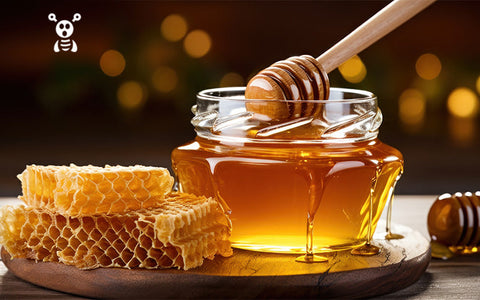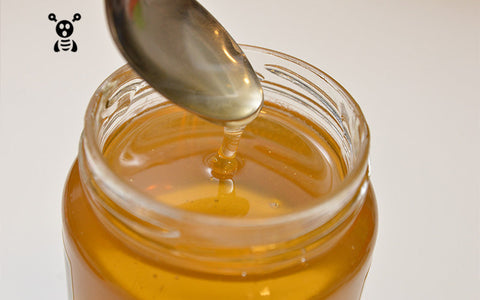Mad honey is unlike any other natural supplement — its potency lies not just in its botanical source, but in how much you consume. While small doses can offer calming, medicinal effects, exceeding the recommended amount can lead to uncomfortable and even dangerous symptoms. Whether you're exploring it for wellness, curiosity, or tradition, understanding the correct mad honey dose is your first step to a safe experience.
Key Takeaways:
- Start Small: 1 teaspoon for first-time users
- Max Dose: Up to 1 tablespoon
- Onset: 20–60 minutes
- Duration: 3–5 hours
- Backed by Science: ScienceDirect
- Legality of Mad Honey: By Country
Why the Right Amounts of Mad Honey Dose Is So Important
Mad honey doesn’t behave like ordinary honey — or even other supplements. Its psychoactive and physiological effects are tied directly to grayanotoxin levels, which vary by source, season, and even individual bee behavior. Too much can tip the balance from helpful to harmful. That’s why dosage isn’t just a suggestion — it’s the line between medicinal and toxic.
Historical Healing Practices
Mad honey's use in ancient civilizations dates back centuries, with records indicating its presence in the medical practices of the Greeks and Romans. These cultures valued the nectar for its perceived healing properties, using it to treat a variety of ailments. In Turkey, where it is known as ‘deli bal’, the substance has been traditionally used to treat conditions such as hypertension and impotence. The people of Nepal also have a history of consuming mad honey to alleviate headaches and relieve cases of insomnia.
Health Benefits
The benefits of mad honey go beyond its historical use, with modern research shedding light on its potential health-promoting qualities. Its soothing traits have been known to provide relief for symptoms of coughs, colds, and respiratory infections. This is due to its natural antibacterial and antiviral properties, which may help combat the pathogens responsible for these conditions.
The honey’s antimicrobial effects can also help with wound healing. Some studies suggest that applying mad honey to cuts, burns, and wounds prevents infection and promotes faster healing. Compounds present in mad honey exhibit strong antioxidant and anti-inflammatory activity, making it a valuable addition to natural wound care regimens.
Moreover, mad honey has been traditionally used to alleviate issues such as indigestion, gastritis, and stomach ulcers. Its calming effect on the digestive system and its ability to fight harmful bacteria make it a promising natural remedy for various digestive ailments.
How Much Mad Honey Should You Take?
Recommended Dosage:
- Beginners: Start with 1 teaspoon (5g)
- Experienced users: Up to 1 tablespoon (15g), maximum once per day
- Do NOT exceed 1 tbsp per 24 hours
When Do Effects Start?
- Onset typically begins within 20 to 60 minutes
- Effects may last 3 to 5 hours
What Happens If You Take Too Much?
While mad honey offers numerous health benefits, it is essential to be aware of its potential risks. These considerations can help you safely enjoy its unique properties while minimising adverse effects. If you're wondering "is mad honey legal", its legality often depends on the region, but safety hinges on proper use and precautions.
Toxicity and Overconsumption
The grayanotoxins in mad honey, while contributing to its calming effects, can pose risks when consumed in excessive amounts. A 2016 NIH study reported the following symptoms of overdose:
- Dizziness, fatigue, sweating
- Low blood pressure (hypotension)
- Vomiting, blurred vision
- Slowed heart rate (bradycardia)
These effects highlight the importance of moderation. To prevent adverse reactions, adhere strictly to dosage guidelines and avoid exceeding recommended amounts.
Allergic Reactions
Individuals sensitive to specific components of mad honey may experience allergic responses, which can manifest as:
- Itching or skin irritation
- Swelling, particularly around the face or throat
- Severe reactions like difficulty breathing or anaphylaxis (in rare cases)
If you have known allergies to bee products or honey, consult a healthcare professional before consumption to determine whether mad honey is safe for you.
Interactions with Medications
Mad honey may interact with certain medications or substances, amplifying side effects or reducing drug efficacy. This is especially true for:
- Blood pressure medications
- Heart-related treatments
- Other intoxicants
If you are on prescription medication, consulting a doctor before taking mad honey ensures that the chosen dose won't interfere with existing treatments.
How to Use Mad Honey Safely
- Always eat with food, never on an empty stomach
- Avoid combining with alcohol or medications
- Consult your doctor if you’re on heart meds or blood pressure treatment
- Start low, go slow
If you're new to this world, read our hallucinogenic honey guide to understand what to expect.
What Science Says About Mad Honey Dosage
Grayanotoxins affect sodium channels in your nervous system — disrupting normal cell signaling and producing both the subtle “buzz” and potential side effects of mad honey. According to a ScienceDirect toxicology review, the line between therapeutic and toxic lies entirely in the dose.
Some research suggests medicinal benefits as well:
Antibacterial activity that may support wound healing
Antioxidant properties for inflammation and immune health
Digestive support in conditions like ulcers or gastritis
These benefits are largely attributed to the rhododendron species used by honeybees during spring harvest — particularly those explored in our deep dive on rhododendron honey.
Mad Honey Laws in Various Countries
Aside from dosage considerations, you need to be aware of the potential health risks associated with mad honey. Ingesting large amounts can lead to toxicity, which may manifest as symptoms such as dizziness, weakness, or blurred vision. For your safety, it's best to buy mad honey from reputable sources and be mindful of its legal status in your country or region, as you might not be allowed to buy the product where you are.
So, is mad honey legal? The current legal status of mad honey varies by country:
• USA:
Mad honey is legal and regulated by the Food and Drug Administration (FDA), which oversees its production, labeling, and sale. If the product complies with FDA regulations, it is considered safe for consumption. However, the FDA can take action if the honey is found to be toxic or poses a public health risk.
• Canada:
The consumption of mad honey is legal. The Canadian Food Inspection Agency (CFIA) regulates its production, labeling, and sale, ensuring it meets safety standards. Nevertheless, individual provinces may have specific regulations, especially concerning substances like grayanotoxins.
• Nepal:
Mad honey native to Nepal and therefore is legal. The Department of Drug Administration (DDA) regulates its production, sale, and consumption, requiring proper licensing and compliance with quality standards. The honey must be appropriately labeled to inform consumers of its potential effects and recommended dosage.
• Europe:
In many European countries, mad honey is legal but classified as a novel food, requiring authorization before sale. The European Food Safety Authority (EFSA) assesses its safety, and products must meet EU labeling standards, providing accurate ingredient information and dosage recommendations.
• Spain:
The use and distribution of mad honey are restricted. The Spanish Food Safety and Nutrition Agency (AESAN) monitors its production and sale, making sure that it meets specific quality and labeling requirements to protect consumers and prevent deceptive practices.
• South Korea:
Mad honey has been banned since 2005 due to its potential health risks and the presence of grayanotoxins, which are prohibited in food products.

Integrating Mad Honey into Wellness Routines
Adding mad honey into your daily wellness routine can be both enjoyable and beneficial. From a culinary standpoint, this treat can be used as a natural sweetener in teas, smoothies, dressings, and marinades, adding a unique flavor profile to your dishes. Its versatility also extends to beauty and skincare, where it can be used in DIY masks, scrubs, and treatments to promote healthy skin and hair. Incorporating mad honey into your self-care practices, like meditation and yoga, can deepen your experience as its calming effects encourage relaxation and inner connection.
Mad honey is truly exceptional, boasting a rich history and a promising future in the world of natural remedies. It's no surprise that its myriad benefits, as highlighted earlier, have caught the attention of enthusiasts and the medical community alike. However, it's crucial to consume this substance responsibly by adhering to the correct mad honey dose. Always follow recommended guidelines and seek professional advice if you have any concerns to ensure a safe and beneficial experience.
Where to Purchase Mad Honey Safely
Are you ready to experience what mad honey has to offer? Look no further than Maddest Mad Honey. Our product undergoes rigorous lab testing to guarantee its premium quality and purity. Also, we ethically source our mad honey and collaborate closely with local gatherers to ensure responsible harvesting practices that protect both the bees and their natural habitat.
Don’t wait! Shop our mad honey online and embark on your journey to holistic wellness today.
Frequently Asked Questions
What is the recommended mad honey dose for beginners?
For first-time users, the safe starting dose is 1 teaspoon (5 grams). This allows your body to gauge its sensitivity to grayanotoxins — the active compound in mad honey. Avoid consuming more until you understand your individual response.
What is the maximum amount of mad honey I can take safely?
The upper safe limit is 1 tablespoon (15 grams) in a 24-hour period. Exceeding this may lead to side effects like dizziness, nausea, or heart rhythm disturbances. Always space out doses and never exceed the daily maximum.
How long do mad honey effects last after dosing?
The effects typically begin 20–60 minutes after ingestion and may last between 3 to 5 hours. Factors like body weight, whether you ate beforehand, and individual sensitivity can affect duration.
Can I take mad honey daily?
Yes — but it should be limited to once per day, and only in small, measured amounts (preferably 1 tsp to 1 tbsp max). Long-term daily use should be monitored, especially if you have blood pressure or heart-related conditions.
What happens if I accidentally overdose on mad honey?
Overdosing on mad honey may result in symptoms like low blood pressure, slow heart rate (bradycardia), nausea, blurred vision, or fainting. These typically resolve within 24 hours. If severe symptoms occur, seek immediate medical help.
Is it safe to combine mad honey with other supplements or medications?
Mad honey may interact with blood pressure meds, heart medications, or CNS depressants like alcohol or sedatives. If you’re on any medications, consult a healthcare professional before use.




